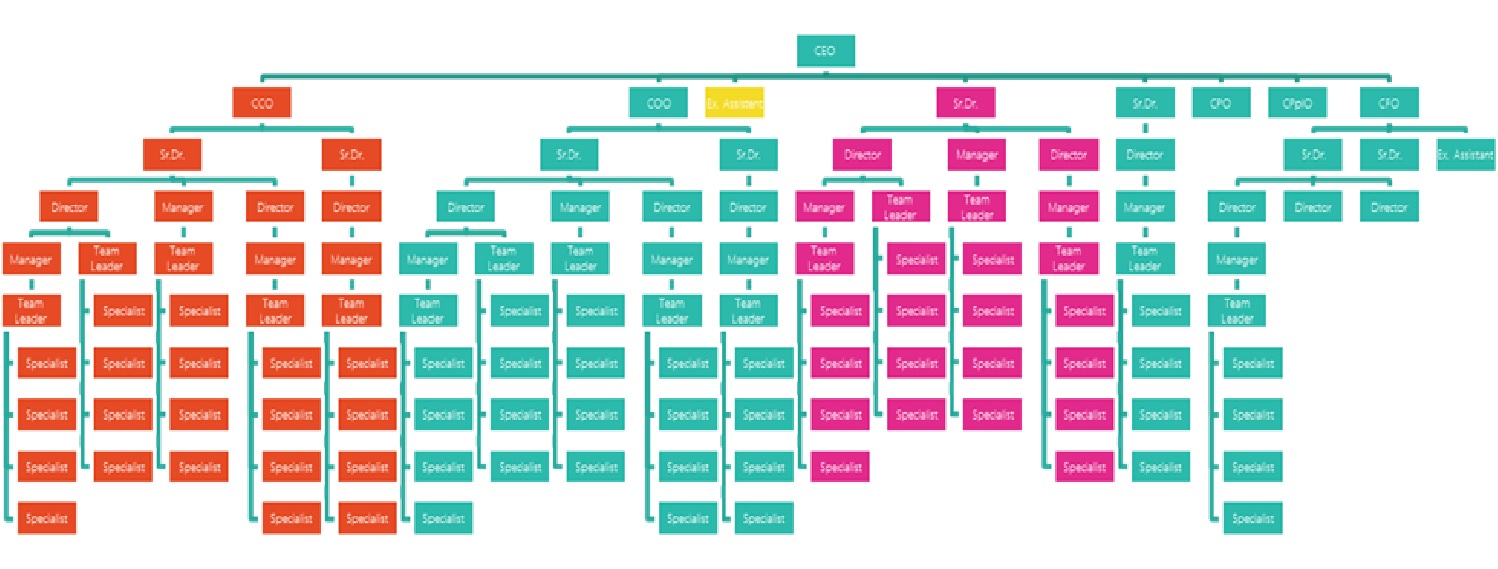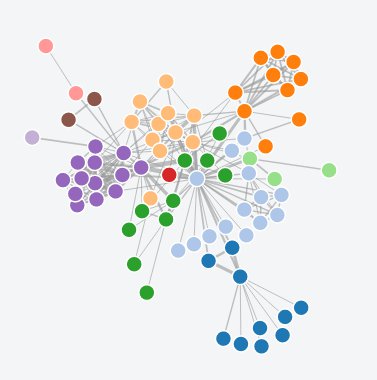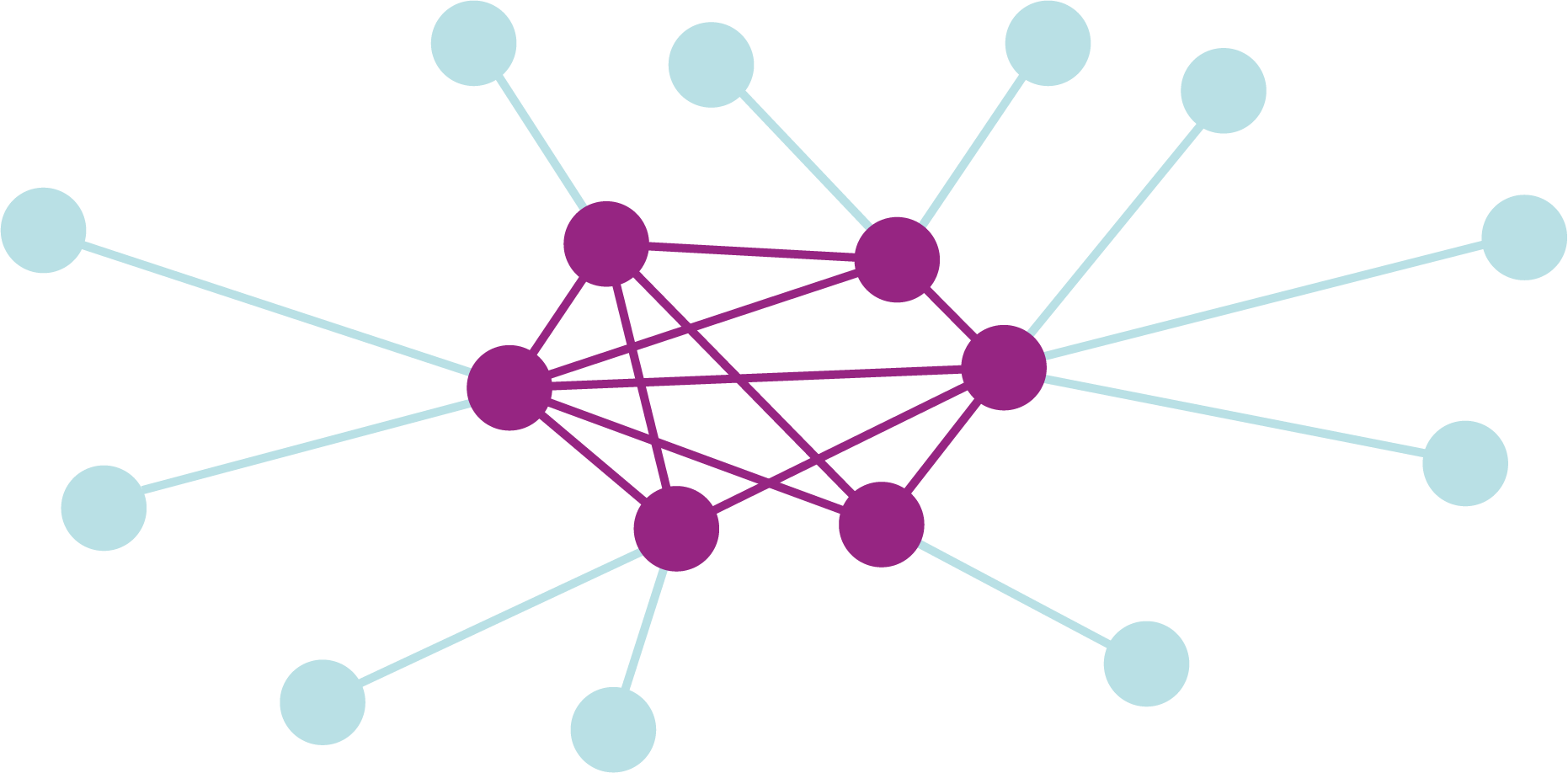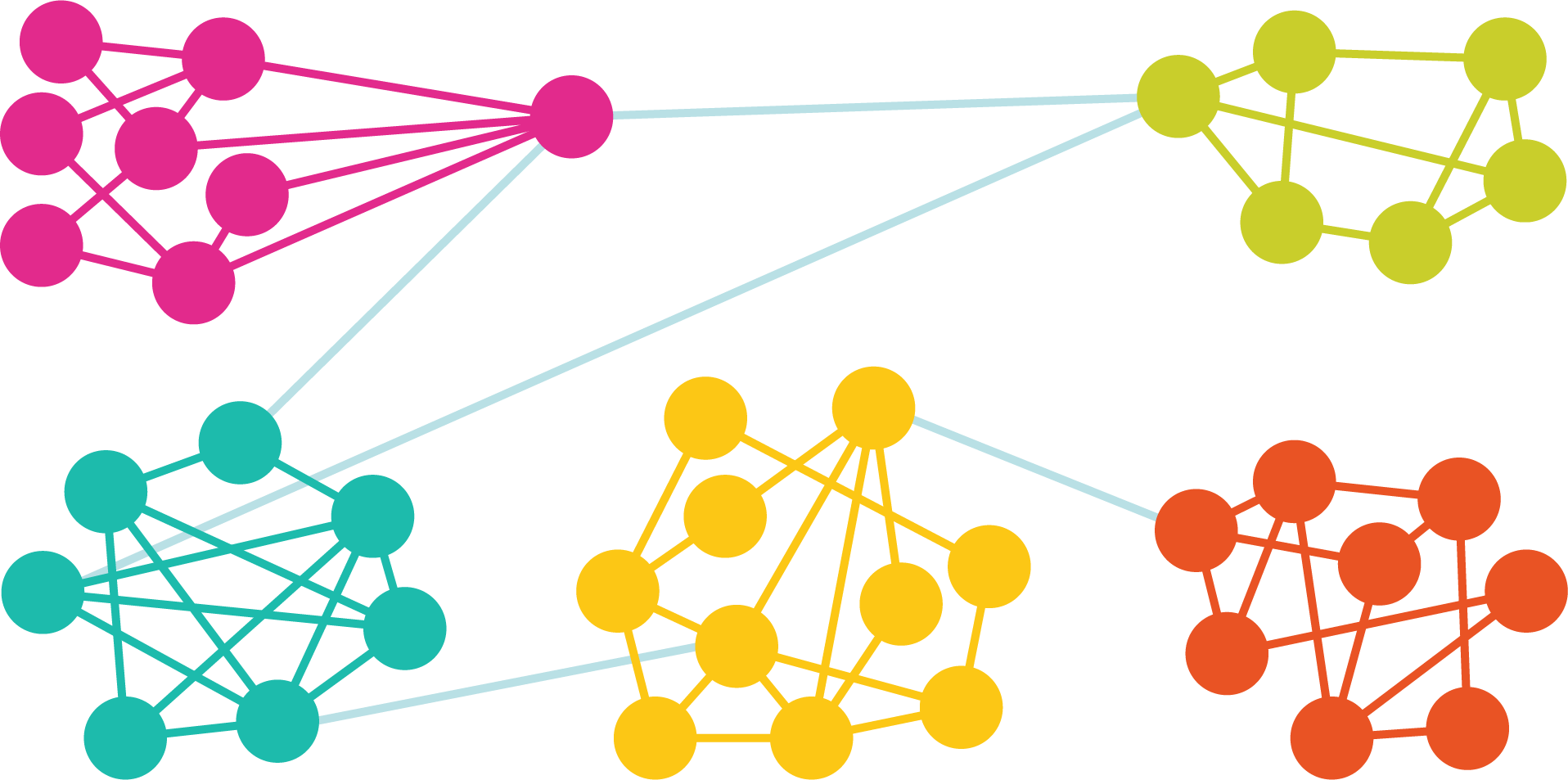The mayor is building a new park. He asks the contractor to only put grass and trees. No paths. The contractor is confused: well.. are you leaving it like that... pathless? The mayor says: we'll know where to put the paths after a year, when people naturally create them.
The good news is that people in our organizations and teams have already charted these paths in the way they communicate with each other. As managers, we try to model internal and external communication based on existing processes and procedures, based on the established organizational chart, that is, based on an ideal vision that often does not conform to the way things actually happen in reality. What if we decided to simplify the processes, eliminate the procedures, and create the organizational chart based on the natural evolution of communication?
In the eyes of management, a company looks like this:

When in reality, it behaves like this:

Through this methodology, you can discover what kind of teams you have in your company, whether their architecture is suitable for the current context, and highlight those people who need backup.
You may discover that you have:
Efficient teams, who communicate internally and intensively, and in which each member also communicates externally with their partners from other teams or companies;

Teams that constantly innovate, which have their own communication networks with other teams, but also communicate internally;

Silo teams, where only one member communicates externally. If agility is the goal, the silo type is exactly what you don't want;

Positions that, by their nature, are the only point of contact for suppliers or customers. What happens if that team member changes jobs? Is there a backup?
The good news is that after 2-3 years of remote and hybrid work, most conversations take place via email, Slack/MSTeams, or calls, and there are logs for these.
That's how I started solving a problem that almost no one said they had: "You can't not be able to retrieve the logs of all conversations. They exist somewhere." That's how I found my passion project for this year: People Analytics - How we communicate tells us how we work.
After intense searching, I found only one study, a wonderful proof of concept, for both communication visualization and machine learning. After talking to many people who were willing to listen to me, I discovered more solutions that use questionnaires, which are very subjective methods of collecting information, by asking respondents with whom they communicate and how frequently. The only slightly more technical solutions are those for risk audit.
The story of a Proof of Concept
To create a proof of concept, I used my own team as a first case study and collected data on communication within Learning Architect from February 16 to March 22 and will create a graph of these communications, by placing team members at relative distances based on their communications with each other and with people outside the company (clients, suppliers, partners).
The chosen period was random and fairly short, so the results were dependent on the existing projects (we worked with some clients during this period, with others in another, and we have internal projects that increase the communication volume of some members), as well as on vacation time (one week of vacation means 20% less communication).
Step 1: Data Collection - Thanks to Technological Advances in Remote Work
The first step was finding sources of information and logs, which we did first for emails. We use Google + Slack + Zoom.
With Google, it was easy, we found the logs immediately. In addition to meta information (date, recipient, sender, ID, etc.) these logs also include the subject line for each email. This will be helpful in classifying emails.
With Slack, it was a little harder: for complete logs, a request and declaration are needed, and access is not instant, but rather easy. Once obtained, they are in JSON format. Conversations are easily anonymized because each user has an identification ID, and each conversation between two users has an ID. Anonymization is simply done by not using/sharing the key that links users and IDs.
The result? Over 38,000 emails to be classified and over 12,000 Slack messages to be attributed.
Step 2: Data Processing - and the Beauty of Networks, in One Graph
If internal emails did not present any problems, external ones were quite complicated to categorize. We even tried to use ChatGPT, but after a 30-minute argument with the AI, I decided to do the job myself at least the first time, even though this meant going through 38,464 lines of Excel. I managed to categorize all emails according to sender, recipient, and subject line into Spam (lots of spam), Calendar Invite (invitations, acceptances, refusals :( ), Client (any sales-related conversation), Admin (suppliers, billing platforms, invoices, proforma invoices, SaaS such as Mailchimp, Sendgrid, Zoom, etc.) and Trainer (of course, our trainers).
The external email part took longer than I would have liked, and to not lose all my patience, I decided to create an immediate small gain for myself, which was the internal communication image.
For visualization, I use a free but powerful platform called flourish.studio.
And the legend:
- Dark blue: Sales - here we also included Stefania, Managing Partner
- Turquoise - Operations
- Slightly lighter turquoise: Instructional Design and Content Marketing, meaning Alexandra
The image is partial (missing Slack conversations and external emails), so I haven't drawn any conclusions yet. Some people are "email people," some people are "Slack people," and the number of internal emails is 5,231, while direct Slack messages are 12,031, and the image is far from complete.
I know, it's already tempting to look for conclusions. But no, there's still a bit of work to be done on Slack. I just need to import them into Excel and do a pivot.
Half a day later.... TA-DA
It's beautiful, isn't it?! I finished it one evening at 11 p.m. I was trying to watch a game, but I knew I only had 30 minutes left to finish it, and I couldn't resist. It's so beautiful. It's beautiful, isn't it?! Honestly, I wanted to print it and sleep with it like my son sleeps with his new toy. It's so beautiful...
Step 3: Insights about the team
First of all... the legend:
- Dark blue: Sales - including Stefania
- Turquoise: Operations
- Slightly lighter turquoise: Instructional Design and Content Marketing, i.e., Alex
- Pink: Our clients (a dot represents a company, not a person. Multiple people can be part of the same point)
- Yellow: Admin (i.e., suppliers, SaaS, supply chain platforms, even clients, but from an administrative perspective)
- Green: Our trainers
Then, the disclaimer, again: this data is from February 16 - March 22, 2023. The data is, of course, influenced by the volume of activity during this period, by active projects. Some people have a higher workload, while others have a lower workload.
And now, finally, the insights:
Team members distribution:
- The Sales and Ops teams are grouped together. This denotes a fair distribution of roles, a healthy structure.
- Andrei is almost in the center of the Ops team, what pulls him slightly outward is the lack of communication with Ada, but only because "they sit face to face" (says Stefania) every day at the office.
- Stefania is the center of the team. As she should be.
- It's a small team, indeed, but all members talk to all members. Each of them has an external network and can bring a different perspective.
- The intense direct discussions between members denote the complete lack of micro-management, the power to make individual decisions, general agility.
And now, about the individual members:
- Ada: Active as a bee. In addition to intense activity with clients, Ada is also involved in our Mentoring for Better Trainers project together with Rox and Stef, hence the intensity of discussions with Rox. Ada, Andrei, and Stef are also present at the office almost daily, so her conversations with Andrei are at the necessary minimum (send me an email so I won't forget, here is the link to the document I was telling you about)
- Alex: due to her role that combines 3 positions, instructional design, content marketing, and trainer, Alex has some of the most diverse conversations. She interacts with trainers (content calibration, feedback), clients (needs analysis), and vendors (communication channels).
- Anca: is a peripheral presence because collaborating with the Learning Architect is not her main activity. You can find out more about her and the wonderful work she does at teamstories.ro.
- Andrei: not the most talkative person on the planet, in the country, in the city, in the company, or at home. Most of my conversations are with my team and vendors. Probably, I could benefit from talking more with clients.
- Gabi: since the pandemic began, we can count on our fingers how many times Gabi met with her colleagues. On the other hand, she spent as much time as she could with her new baby, Andrei. However, Gabi maintained a strong relationship with clients and is slowly reaching a pre-pandemic workload volume. But until then, she will get some colds from kindergarten, and Easter will come...
- Horia: ah, the passionate project manager who talks to any client he finds. He is not really interested in talking to vendors; he makes things happen.
- E1, aka Ioan, our graphic designer had an external project, and he developed a concept and a product directly for the client this month, hence his direct discussion with the client. In other situations, he only has internal discussions. His favorites are Horia (probably for common projects and some DnD and gaming in general), Alex (marketing visuals, final presentation arrangement), and Andrei (E1 is new to the team, and he is still calibrating his output with the direct manager).
- Iolanda - her role is Training Support, and she will soon become a Project Manager. She ensures that the trainers have everything they need during courses, which is why she mostly talks internally with Rox and Horia, the project managers, and with Alex as the instructional designer, and externally with print suppliers. The thin line between her and Andrei is due to the fact that she is independent and her work requires her presence in the office, where Andrei is, so their discussions will be more face-to-face. What does not appear in this graph are the discussions with trainers because she has them on WhatsApp.
- Rox: oh, Rox. Rox, the future mother. Rox, who celebrates her last week at the office before her prenatal leave. Rox had not only many active projects this month, but she was also the one who organized the entire Mentoring for Better Trainers project. When Andrei saw this image, his first thought was "f@#k, the problem with replacing her is not replacing what she does, but with whom she does it." Rox's latest major project was to introduce Iolanda into all the conversations she had and pass the baton to her.
- Stefania: "I would like not to talk about administrative things with anyone" said the Administrator. We will make sure to not. Stefania has many hats, from administrator, company image, sales, instructional designer, trainer, leader, to coach. She is in the center.
Next step: I was tempted to test sentiment analysis with ChatGPT, and the results were amazing. After a short but specific prompt ("please evaluate the following text from a sentiment analysis perspective, giving it a score from -100 to 100, where -100 is very negative and 100 is very positive") and training on four messages, on the message "man, o sa fiu online cu voi in meeting astazi, sorry", it replied with
"From a sentiment analysis perspective, the text 'man, o sa fiu online cu voi in meeting astazi, sorry' can be evaluated with a neutral to negative score, approaching -40. The word 'sorry' suggests that the speaker feels guilty for their absence or delay in the meeting. However, the use of the word 'man' suggests an informal and friendly familiarity with the interlocutor, which can add a positive note to the message."
Impressive. As tempting as it was to use this system to analyze all messages, I decided to postpone this step until I build a system that anonymizes and, above all, hides the content of the messages from myself. What's important is that it's within reach, all that's missing is some coding.
Did we learn something new?
Definitely. Even though we are a small team, even though we are very open with each other, even though we have multiple roles, we are agile, yes, we learned something new.
And, in the end: applicability
This tool can be used on three major levels:
- At the organizational level
- At the team level
- At the individual level
At the organizational level, the context is important. We can talk about the situation of a reorganization; the tool can monitor, confirm, or refute the success of that reorganization. We can wait for financial results or 2-3 engagement reports to see a trend movement, or we can instantly measure whether people are working in new ways or have remained set in the old system. Measuring "sentiment" can give us instant information about employee morale and workload.
Also, a complete and frequently updated picture can even initiate a reorganization, at least of some departments, to follow the information flow and facilitate communication. Intense electronic communication can be easily substituted by rearranging offices and bringing people who need to communicate with each other closer.
At the team or project level, we can observe the types of teams (those from the beginning of the article) and act accordingly. We can observe high-performing teams in terms of communication in a hybrid setting and the opportunity arises to create a standard for all other teams in the company (rituals and actions that facilitate communication).
At the individual level, there are some notable typologies:
- The central connector - the person who communicates with the most people in the organization or team. Sometimes, as is the case with the Learning Architect, it is the manager, the leader, but not always. This is one of the most important things in the organization/team because it makes information circulate, speeds up things, people find out news through them.
- Crane operator - the person who connects two groups. They have a vital role in the team or project. Without them, communication, trust, and collaboration are lacking. It is interesting to see in these cases whether communication through the crane is something natural or whether it is a situation created by micro-management.
- Information broker - the person who communicates with a large number of individuals or teams. They are different from the central connector because they do not necessarily communicate internally, nor with everyone, and they are not at the center of the organization/team. Sometimes these roles are natural (sales or procurement employees will be the point of contact for customers and suppliers with the organization). In our case, each of us is a broker for people outside the organization. These people present an increased risk if they decide to leave the company or team, and ideally, they have a backup.
- Peripheral specialist - the person who has a single contact, expertise, and is a specialist. Again, losing contact with them and access to their expertise is a risk.
Once these typologies are identified in the organization or team, we can benefit from the advantages of each role or minimize the risks.
Another immediate applicability would be to have live information about the integration of new employees. We want them to communicate as much as possible with as many people as possible, especially in the first month.
If you've read this far, it means it was interesting. If you want to continue the discussion, please do so by writing to me at analytics @ learning - architect. ro. Seriously, do it. Since I started this project, that's all I've been talking about, and I honestly think the people at the office are getting tired of it. It would be nice to have someone to talk to about insights, methods, GDPR requirements for implementing such a project in a larger organization, about doing this with Microsoft technology, about how it could be implemented in a (much) larger company.
People Analytics – The way we communicate says a lot about how we work

